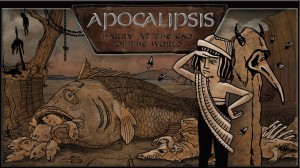Review for Karma. Incarnation 1

It’s not very often I finish a game and have absolutely no idea whether I actually enjoyed it or not. The wordless, psychedelically stunning, utterly bizarre and often nonsensical puzzler Karma. Incarnation 1 from AuraLab is one such game.
Karma begins with two young spirits floating around the ether, contentedly in love. When one of them is captured and taken to the world below by monsters, it falls to the other to follow along and rescue its partner. Our hero in this tale, Pip, dreams of being reincarnated as a mighty dragon, capable of destroying the evil intruders and reuniting with its love, but is instead born as a kind of bloated tadpole with a big mouth but no arms or legs, so the task will not be easy. Along the way, picking between good and bad moral choices is meant to help Pip learn more about the nature of karma.
While the basic premise may be fairly coherent, it’s the last and really only thing that is clear in a game that seems to delight in its impenetrable absurdity. Even after finishing its total playtime of around two hours, I still don’t really understand much of what happened.
This brings me to the first major point: This is an adventure with no text, either spoken or descriptive. Like in games such as Machinarium, you piece together the story via pictogram thought bubbles emanating from Pip and other characters you meet. A very basic example of this occurs when you encounter a junk cart. Talking to the creature pulling the cart brings up an image of a sad looking heart, from which I surmised the creature was depressed and might be cheered up if I brought it something it likes. Everything in Karma is communicated this way, but the image depictions are wide open to interpretation. Where one person might assume, as I did, that the creature is sad, another might just as easily believe it is sick or injured. And this is one of the more straightforward examples. Some are so cryptic that they will almost certainly leave you completely bewildered as to what’s required next.
Most of the time, I really had no idea what was going on with the story beyond having a vague feeling of progression as I kept moving to different areas, comprised of one or two side-scrolling screens each. Early on you gain access to a travel machine of sorts that takes you to a new location when you’re done in the current one (only near the end is any backtracking to previous worlds required), and in each place I had to undertake a series of puzzles and tasks that felt like they were just there to halt my progress. Every subsequent scene, while unique in look, felt quite repetitive in that I encountered an obstacle, found an object, and took the object to the obstacle to resolve the issue in order to move forward.
The actual controls for doing all this are very simple and efficient: just click on the spot you want Pip to slither to (if accessible), or on the hotspot or thought bubble you want to activate. Collectable objects are swallowed by Pip and stored in inventory, but item use is essentially predetermined in the appropriate places so no experimentation is necessary. Most objectives are quite easy to see and don’t require any pixel hunting, so the only challenge is in working out how to accomplish your task. There is an intermittent hint system if you need it, available by pressing a light bulb icon that causes Pip to indicate a course of action. Like all thought bubbles, though, these clues are open to interpretation so I found them only sometimes helpful. The one other thing to note about the mechanics is that there doesn’t seem to be a settings menu anywhere, so I couldn’t change volume, speed or even play the game in a window, an oversight I found very frustrating.
The karma system is presented through moral choices you make during the game, displayed as two thought bubbles above Pip’s head. Early on you get the choice of how to deal with someone who’s hanging from a frozen cliff, either to save the person or let them die. I chose to save them. I didn’t have an in-story justification for this action, as there wasn’t an obvious incentive to do so and truthfully I just felt like the game would reward better behaviour. While apparently these moral choices can change the story and make a difference later in the game, I didn’t see anything in my playthrough that indicated I’d ever made a poor decision (besides spikes growing on Pip’s back to reflect wicked deeds). I only felt inclined to play the game once, but you have the opportunity to redeem your immoral acts before the end anyway, so being a little evil doesn’t seem to have any permanent consequences.
The most glaring reason I only played it through a single time is that Karma. Incarnation 1 is slow. Painfully slow. Pip moves slowly. All the animations are slow, and as everything animates, you’re constantly waiting for that animation to slowly finish. Even simple movements like Pip turning toward you and shrugging when you try an unintended action are frustratingly slow. I believe this is largely because the game has no text. Since everything needs to be shown, there is a lot more animation than is usually necessary in an adventure game. The animations look good, but the sheer number of them means you’re spending a large amount of time watching the spinning timer icon while waiting for them to finish.
The biggest strength of the game is the graphics, which are quite simply amazing. Karma’s art is hand drawn and incredibly detailed in a surreal, even psychedelic cartoony style. The opening scenes take place in a cave network that Pip must navigate. These caves feature a red palette for the most part, evoking a sense of confinement and depth remarkably well, further enhanced by sections cloaked in darkness until you’ve overcome the obstacle needed to reveal them. Pip then moves to an area all in blues and greens, showcasing a clearly alien setting and offering a sharp contrast to the caves you just exited. Other scenes include an ice-filled landscape animated with a raging snow storm, a yellow and green-infused environment that appears to be some sort of junkyard, tranquil green alien forests, and my personal favourite, a stone canyon taken over by a rock concert with all the partying and rainbow lighting one would expect from such a show.
The world that AuraLab has created is as diverse as you’ll find in an adventure game, with a wide variety of unique settings all teeming with animations that bring the scenes to life. And yet as different as the locations are, they share a graphical consistency that makes you feel like they’re all part of the same connected world. Karma simply doesn’t miss with its stylish artwork and there never seems to be a static background with nothing going on.
The music is also done really well, with the score matching the visual design perfectly. From the ambient cave noises in the underground areas to the concert music later on, each area has a distinctive sound that, like the artwork, although diverse maintains a familiar continuity throughout.
Adding to the beautiful art and audio is the astral sight feature, where with the simple press of a button or tap of the space bar, your immediate surroundings are converted to an even more wildly colourful experience. Sometimes this reveals details that are less obvious or even invisible otherwise, and occasionally it’s a requirement to move forward in the game, such as inside your transport where only the use of astral sight reveals the wheel puzzle you need to align. It’s a great feature that adds another small but welcome layer to the gameplay.
The puzzles in Karma come in two main forms. Inventory obstacles are the most common and are all fairly intuitive, so you can complete them with little real effort. Adding to the simplicity is the fact that most of them can be solved with an item in Pip’s immediate vicinity, although there are a couple of situations where you use objects long after acquiring them. The other form of challenge involves actual puzzles such as connecting different shapes into a single pattern, or spinning dials until they align properly. One particularly well constructed task relates to playing drums in the ice location. The goal is to play the drums in time with the other characters so as to make their fire bigger and help a frozen character thaw out. It’s a challenging little sequence and a nice change of pace at the time, combining the musical score and gameplay together in a way that’s rarely seen. All these standalone activities are strategically placed to break up the more standard find-and-use quests.
So with all that said, did I like the game? I’m still not sure. Karma. Incarnation 1 is a unique adventure that give credence to the belief that games can be art. The visual work is outstanding and the clear highlight of the experience, but it’s let down by the slow speed in getting anything done and by a story that, quite honestly, is so vague and abstract as to be meaningless in driving the action forward. If you’re a fan of largely linear, Amanita-style games that don’t have any words, you may enjoy this short, vividly designed puzzler more than I did, though it will likely still depend on your tolerance for nonsensical stories and somewhat simplistic gameplay. For me, finishing Karma left me unsatisfied and with a feeling of confusion, though at only two hours, it is not without a certain amount of appeal along the way. The ending confirms what the title suggests, that there are more “incarnations” to come, so here’s hoping the series evolves into something a little less obtuse the next time around.





























